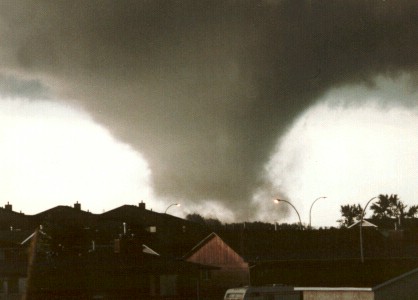| Back to Back Issues Page |
 |
|
Blowin' in the Wind, Issue #084 Speed of Tornados - July 1, 2011 June 29, 2011 |
Hello ,What is the Speed of TornadosI occasionally get asked about the speed of tornados. In the past months since tornado season started in April, the news has been trending with the topic of tornados hitting many areas in the United States. Even those places not considered in the so-called Tornado Alley or areas not typically visited by strong tornados were devastated. Many lives were lost and millions of dollars worth of property were damaged in states like Alabama, Mississippi, Tennessee, Georgia and Virginia from tornados with winds between 160 to 200 miles per hour (mph). Here is a classic that occurred in Edmonton, 1987.
So, what exactly is a tornado?Scientists define a tornado as a dangerous, destructive and violently rotating column of air in contact with a cumulonimbus cloud and the earth's surface. Tornados come in many shapes, sizes and speeds from the multiple vortex twisters to the land spouts and water spouts.The most typical appearance of a tornado is a visible condensation funnel with its narrow end touching the earth. It may also be encircled by a cloud of dust and debris because of the strong winds generated on the surface. The wind speed of a tornado can vary from less than 110 mph to 300 mph with an area stretching anywhere from 80 meters to 3 kilometers across. Tornados are known to travel for considerable distances often stretching for over 100 kilometers in extreme cases. Think of a twister gaining speed and strength as it travels through the land, uprooting everything in its path and leaving a scene of utter destruction and you have an idea of its sheer power. The next question then is: How does a tornado start?The answer to this question will help us understand the the causes of tornados and factors that affect the speed of these awesome if destructive natural phenomena.Often, the most intense tornados develop from supercells, which are a class of thunderstorms accompanied by other natural phenomena like heavy rain, tornado clouds, strong wind gusts and frequent lightning. These supercells have mesocyclones that are areas of organized rotation found just a few miles in the atmosphere. As the heavy rainfall drags on descending air, the resulting downdraft gains speed as it approaches the earth's surface. The rotating mesocyclone is then dragged down to the ground resulting in the visible funnel and other signs of a tornado. The dissipation stage happens when the tornado's air supply is choked off and the vortex starts to weaken. The factors that affect the direction and speed of tornados are also the factors that affect wind. Although each tornado will behave in a different manner than the one that came before or after it, the factors that influence it include:
The wind speed of tornados is often estimated from various sources with the most common being the amount of damage inflected on the affected area. Scientists have developed the enhanced Fujita scale to assign tornado speeds with the associated damage such that EF0 is the weakest at 65-85 mph and EF5 as the strongest at over 200 mph. |
| Back to Back Issues Page |
